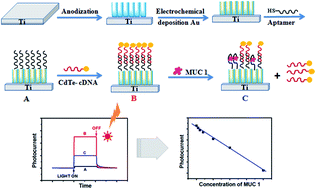A photoelectrochemical aptasensor for mucin 1 based on DNA/aptamer linking of quantum dots and TiO2 nanotube arrays†
Abstract
Herein, a novel strategy for the construction of a photoelectrochemical aptasensor for tumor marker mucin 1 (MUC1) was presented, which was based on the effective photoelectron transfer from CdTe quantum dots (QDs) to TiO2 nanotube arrays (TiO2 NTs) through DNA chains. First, we prepared a series of TiO2 NTs on titanium foil by the electrochemical anodization technique, and electrodeposited Au nanoparticles to improve their electrical conductivity and biocompatibility, which could load a high amount of MUC1 aptamers by Au–S bonds. Then, the synthesized c-DNA@QDs were immobilized on the TiO2 NTs by hybridization of c-DNA and aptamers to form a TiO2 NT/aptamer/c-DNA@QD aptasensor. Detailed studies indicated that, under the irradiation of visible light, the aptasensor had a good photocurrent response due to the excellent photosensitivity of CdTe QDs and electrical conductivity of DNA chains and Au/TiO2 NTs. More importantly, the photocurrent response of the aptasensor was significantly affected by the TiO2 NT morphology and DNA chain length, which could be regulated by changing the tube length of TiO2 NTs and the chain length of DNA linking QDs and TiO2 NTs. Furthermore, the TiO2 NT/aptamer/c-DNA@QD aptasensor for MUC1 exhibited good reproducibility and stability, a wide linear range of 0.002–0.2 μM, and high sensitivity with a LOD of 0.52 nM, which could be applied to the determination of MUC1 in human serum samples with good accuracy and recoveries. Therefore, the developed aptasensor could offer a promising feature for the analytical application in complex biological samples.


 Please wait while we load your content...
Please wait while we load your content...